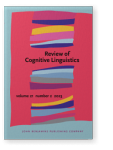Vol. 21:2 (2023) ► pp.377–410
Separation events in Mandarin, Russian and Korean
A crosslinguistic event-categorization study
Crosslinguistic studies on motion events have revealed that S-languages demonstrate finer-grained lexical categories than V-languages in representing motion manners/gaits. But these studies were restricted to the semantic domain of motion events and confined to a limited number of S- or V- languages. In this paper, we further investigate whether the association between lexical diversity and language typology is manifest in a similar way in the semantic domain of separation events by focusing on Mandarin, Russian and Korean. Our results suggest that: (1) Separation expressions support the diversity-typology correlation proved in motion expressions because the two S-languages Mandarin and Russian demonstrate richer lexical diversity than the V-language Korean; (2) It is further pointed out that apart from language typology, lexical diversity is influenced by multiple factors including lexical resources, conceptual salience, event construal, and event type; (3) Though typologically different, these three languages, in their lexical naming of separation events, are constrained by the biomechanical structure and follow the principle of prototypicality. Overall, this study opens up a new crosslinguistic perspective by showing how lexical diversity is typologically and linguistically driven.
Article outline
- 1.Introduction
- 2.State of art
- 2.1Motion event categorization
- 2.2Separation event categorization
- 2.3Motion-separation comparison
- 2.4Mandarin, Russian and Korean
- 3.Method
- 3.1Participants
- 3.2Materials
- 3.3Procedure
- 3.4Coding scheme
- 4.Results and discussion
- 4.1Lexical diversity
- 4.2Beyond S-/V- typology
- 4.2.1Lexical resource
- 4.2.2Conceptual salience
- 4.2.3Event construal
- 4.2.4Event type
- 4.3Structural constraints and event categorization
- 4.4The continuum of event categorization
- 5.Conclusions and implications
- Acknowledgements
- Notes
- Abbreviations
-
References
